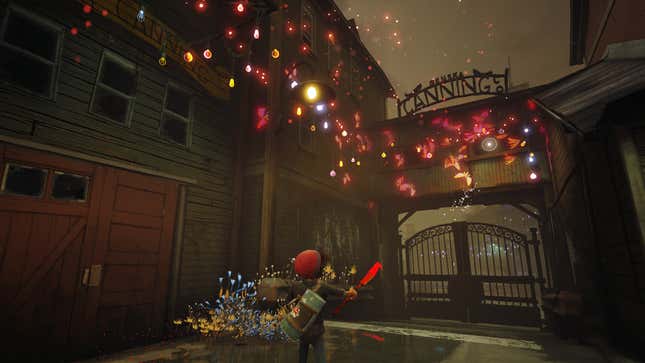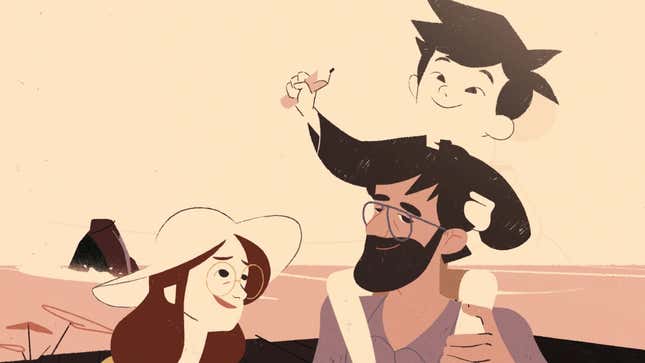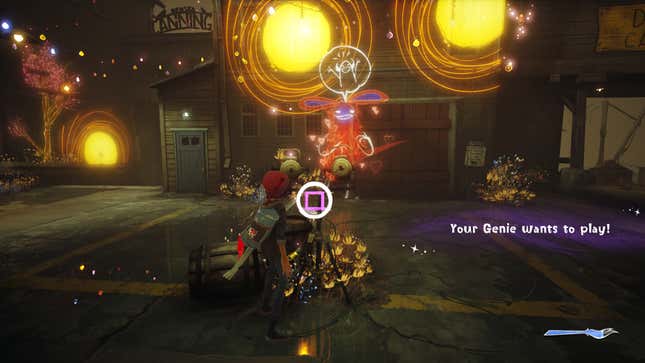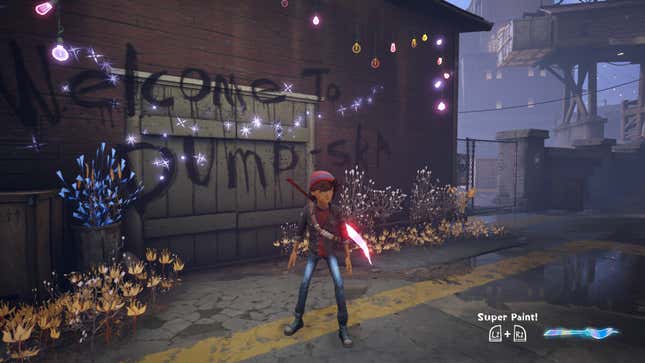When I started Concrete Genie, a new PlayStation 4 exclusive out now from Pixelopus, I was swept into its world. The game’s setting is lush and alive, its narrative heartwarming: A latchkey kid named Ash constantly revisits the ruins of Denska, the once-thriving port town he grew up in, to doodle. Denska has been abandoned and overtaken by Darkness, a mysterious force with the physical form of thorned purple vines, but Ash can’t stand to let the town go. He’s faced with the opportunity to take action, given a magical brush and a mission to restore the ghost town’s beauty. With a masterful sense of visual storytelling, the story is charming in its simplicity, full to bursting with warm, colorful memories and touching moments.

This piece was first published at midnight.
The gameplay never quite lives up to the loving design of the ramshackle town. After maybe 10 hours scouring for secrets and messing around in free play mode, I wasn’t pulling my hair out. I just got a little bored with it. That did make it painful when I reached the short-lived final act, a total upturning of its mechanics, and realized that the gameplay was actually getting good.

Ash progresses by moving through city streets and across rooftops with the aid of his Genies, creatures he’s drawn in his sketchbook. Each setting—a derelict lighthouse or a deserted hydroelectric plant, for example—features similar objectives. You must paint walls adorned by lightbulbs to illuminate them; find pages of your destroyed sketchbook, which can include new designs for the walls or the Genies themselves; and find spots to create new Genies. In the process, you can find newspaper clippings that provide extra context about the city of Denska, the environmental disaster that totaled it, and the tough-as-nails townsfolk who stuck it out for as long as they could before having to leave. Denska is still full of signs of life: leftover bottles and cars, neglected storefronts with stacks of CRT TVs, cheerful advertisements fading to a sullen gray. While finding one newspaper clipping, Ash remembers aloud the moment his family realized it was over: “when mom realized there was no place in town to buy milk.” It’s a simple story, expertly told.

The problem is, playing through the game gets boring. After your first encounter with the Genies, you’re able to graffiti up most of Denska’s walls using either motion controls or the right stick. At certain locations, you can create new Genies with a similar interface, starting with the body and adding designs like horns, ears and tails. While there’s not an incredible amount of variety across the several bodies you get, the creatures are a clear nod to Where the Wild Things Are and carry with them a real charm. The landscape options, anything from redwood trees and storm lilies to mushrooms and balloon plants, all look good, as do dynamic effects like the rain, which continues to fall whenever you pass by the wall. Butterflies and birds flutter outward from your brush, to your Genies’ great delight. But you get a total of 48 of these options to mess with, 12 each between four areas, and in a post-Little Big Planet world, it wasn’t enough to justify how much repetitive painting I had to do across wall after wall.
At the end of each area, you’re invited to paint a “masterpiece,” a larger mural, where your Genies will have suggestions about what to put up. Despite the monotony, doing this is fun and sometimes happens in cool places, like a section where you climb high above the city and can see the entire town. Along the way, you can also find billboards to spruce up where you need the correct design. Completing puzzles like this unlocks rewards like concept art, which, unsurprisingly, is stunning.

Each of the three Genie types has its own powers, which can do things like set parts of the environment on fire for you to pass through. Puzzles largely consist of clearing Darkness so that your Genies can get through and magic away environmental obstacles. Sometimes, you have to paint a design the Genie requests in order to get them to help you, but that doesn’t add much and ultimately feels like a chore. Seeing some of the Genies’ interactions with your landscape paint is cute, but when the puzzles are already tedious, having to draw, I don’t know, some grass before your Genie will cooperate gets old.

Concrete Genie rarely requires any real problem solving. This is one issue I can just barely excuse because it seems to have been made for a younger audience. Puzzles are straightforward, and the Genie you need to progress is always the next one you find, precluding any real puzzling beyond exploring and finding new areas. But undermining this is the fact that the gameplay often feels undercooked. Even as an adult, I found myself occasionally confused about how to progress. The game aggressively offers hints, which felt like a bandaid on moments of loose design. The puzzles generally featured only one way to progress, and the way forward, no matter whether that was using a water valve or flipping a switch, was generally to interact with the one interactive thing and then call your Genies. That was occasionally marred by the fact that it wasn’t always clear, for example, when a Genie would be blocked by Darkness given the nonlinear way they move through walls. Ultimately, it felt like there was this rich, beautiful world and too little to do in it.

You sometimes have to avoid bullies as you progress. Learning more about the kids who torment Ash with Senseless Kids’ Movie Thuggery is interesting, but the “stealth” really just requires you to jump on any nearby rooftop and you can’t be caught. Like the rest of the game, it works well narratively but fails to be fun.

I felt this frustration most when I got closer to the end, where the gameplay…actually got cool. After a certain point, the mechanics entirely switch and you’re in pursuit and combat situations, with abilities like “Paint Skating,” which allows you to glide around the town more quickly, and you get fireballs to shoot enemies with. Without giving too much away, you have to fight and then tame beasts using a number of offensive magical powers you get. You even get a dodge roll to use, which was far better than trudging around the streets of Denska like a regular, non-magical pedestrian. The action section is far more fun than sneaking around Ash’s bullies and painting by number. The story continues to pick up here as well as Ash confronts his tormentors in a deeply affecting, earnest final act. Unfortunately, this part of the game is short-lived after the slog it takes to get there, but the decision to end on this note was a smart one. If only Concrete Geni had gotten there sooner or stayed there longer.

The story of Concrete Genie is well-told and relatable, a classic bullies-turned-friends story of empathy and growth with some real storytelling flair, including striking illustrations and a masterful, coherent use of a variety of art styles. The account of environmental disaster and a fishing town struggling to survive is rooted and told well from Ash’s young perspective. Pixelopus has a clear understanding of what makes a story work, even a story done as many times as this one: bullying, empathy, reconciliation. The fact that the game is gorgeous goes a long way, too. With the amount of love and care poured into the storytelling, I wanted more from the gameplay. If the first part of Concrete Genie were more tightly done, it could have easily been one of my favorite games of the year. But like the fishing town of Denska itself, it faded before I could really appreciate it.






